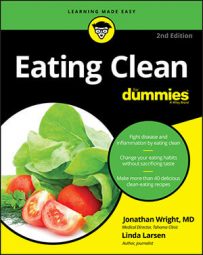Here's the lowdown on what the two types of fiber do:
- Insoluble fiber: This type of fiber helps food and other materials move through your gastrointestinal system. It also makes going to the bathroom a bit easier. In other words, if you eat a lot of clean, fiber-rich, whole foods, you won't have a problem with constipation.
Insoluble fiber helps prevent the development of diverticulitis (inflammation of the small pouches in the colon that develop as you age; when these pouches become inflamed, they can harbor bacteria). It also slows the absorption of sugar into your bloodstream and helps control the acidity in your intestines. The bulk provided by insoluble fiber keeps things moving in your intestines, which may help prevent cancer.
You find this type of fiber in the bran of wheat and corn, in seeds and nuts, in other whole-grain products, and in fruit and vegetable skins. Leafy vegetables and fibrous vegetables like green beans are also good sources of insoluble fiber.
- Soluble fiber: This type of fiber dissolves in water and forms a gel material. Nutritionists now know that this type of fiber is critical to good health. It can lower blood cholesterol levels and stabilize glucose levels, which may help prevent type-2 diabetes. Soluble fiber binds with bile acids in the intestines, removing them from your body. Your liver then makes more bile acids from the cholesterol in your blood, which reduces overall cholesterol levels. This type of fiber can also reduce inflammation and blood pressure.
Soluble fiber keeps you feeling fuller longer after a meal by slowing down the rate at which your stomach empties so that you don't want to eat again too soon. Good sources of soluble fiber include nuts, barley, fruits, vegetables, oat bran, dried legumes, and psyllium husks.

